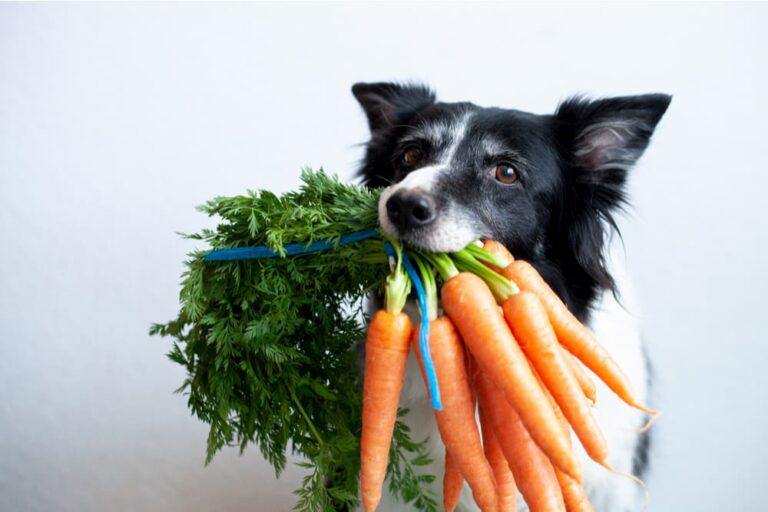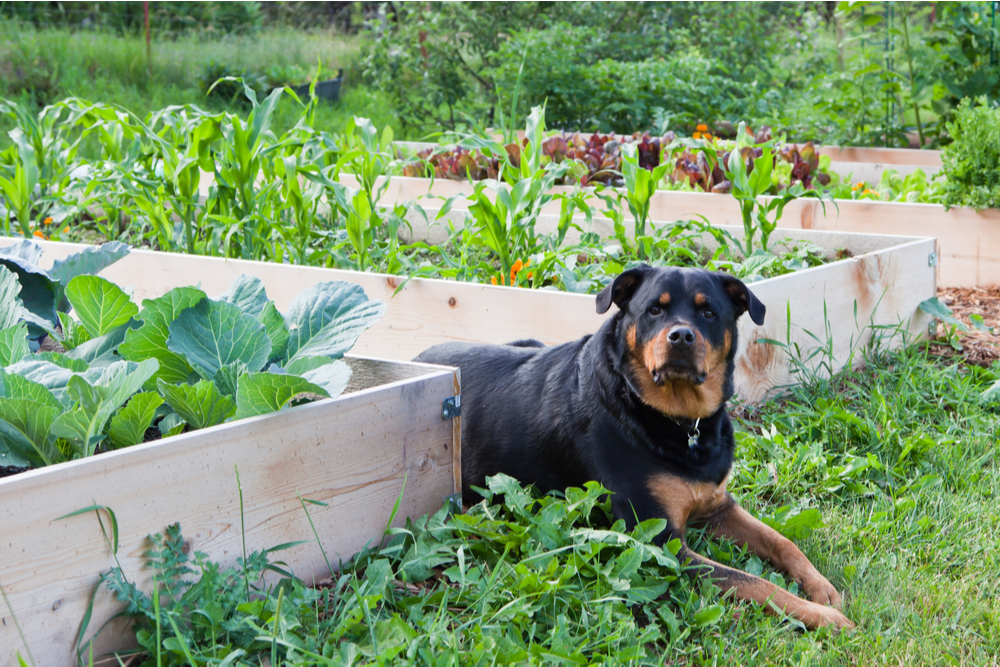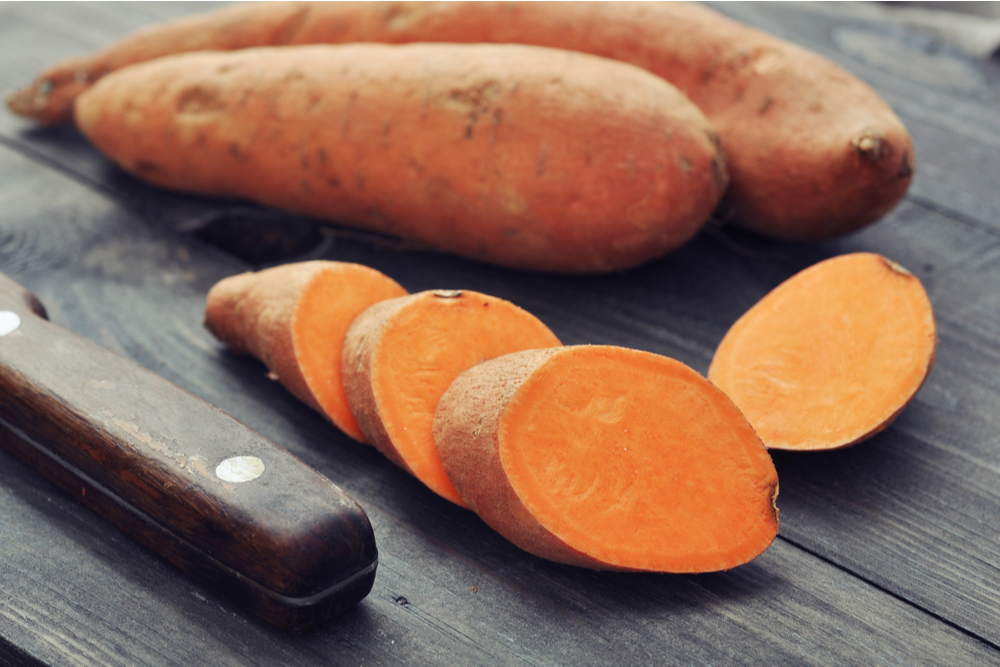12 Vegetables Dogs Can Eat

Since we were little humans, we were bugged by our parents to eat our vegetables. Whether you love vegetables or not, you know they are good for you. And it turns out, vegetables are good for dogs too.
Because vegetables do not carry significant calories, they are a great consideration for between-meal snacks and treats as well as helpful additions to a complete and balanced dog diet.
Vegetables provide large amounts of vitamins, minerals, and antioxidants as well as a healthy dose of fiber.
Whether you want to add vegetables to a homemade dog food, imbue some extra flavor to your dog’s kibble, or have a snack or treat option to help your dog stay healthy, you have come to the right article.
Are Vegetables Good for Dogs?

In general, vegetables are good for dogs. There are a few notable exceptions such as onions, garlic, leeks, shallots and chives that could be dangerous—and even toxic—to dogs.
But overall, vegetables are low-calorie, high in vitamins and minerals, and they provide fiber to help dogs feel full between meals. Vegetables can be added as a topper to your dog’s current food, be included into a homemade diet that has been vetted by a veterinary nutritionist, and can serve as treats or between-meal snacks to keep our dogs feeling satiated.
Overall, vegetables are low in fat, but many provide our dogs with protein. This makes vegetables a good snack or treat choice for dogs who are overweight, dogs who currently have pancreatitis or have had pancreatitis, and dogs with diabetes. The fiber provided by vegetables has beneficial effects on blood sugar levels, and helps healthy intestinal bacteria to thrive, while also promoting normal bathroom habits.
But despite all the positives of veggies for dogs, it is possible for pet parents to feed their pups too much of a good thing. If you have a dog that will eat anything you put in front of them, offering too many vegetables can cause bloat. In dogs with bloat, their stomach can get so stretched with food that the stomach has trouble pushing that food down into the intestines and instead will cause stomach pain.
Often, dogs with bloat will need help from some medications and fluids at the veterinary hospital to feel better.
Best Vegetables For Dogs

The levels of vitamins and minerals in each individual vegetable can differ widely. Below are a list of vegetables that can be fed to dogs, and some nutritional highlights for each vegetable.
Asparagus

Asparagus is a vegetable that you may not have considered giving to your dog before—but dogs can eat asparagus and this stalk-shaped veggie has a great deal to offer. Asparagus is an all around good source of many vitamins and minerals needed on a daily basis and provides a good dose of antioxidants to help control inflammation in your dog’s body.
Broccoli

Broccoli, a cruciferous vegetable related to cauliflower and brussels sprouts, is a great vegetable for dogs. Broccoli is a good source of protein, is an excellent source of vitamin K, vitamin C, and folate, and provides dogs with a dose of potassium and manganese.
Another perk of broccoli for dogs is that it provides a variety of bioactive compounds including kaempferol and sulforaphane that can help manage inflammation in the body.
Brussels Sprouts

Brussels sprouts are a good source of vitamin K, vitamin C, and alpha-linolenic acid—also known as ALA (an omega-3 fatty acid).
Vitamin K is most notably important for the creation of proteins involved in normal blood clotting. Dogs can get their vitamin K through healthy intestinal bacteria, or by eating a food that contains vitamin K. Pets who have intestinal disease or are on antibiotics—and may not have a healthy intestinal bacteria community—may benefit from a boost of vitamin K from Brussels sprouts.
Carrots

Carrots are a good source of soluble fiber and beta-carotene, which is converted to vitamin A in your dog’s body.
Soluble fiber can help temper blood-sugar spikes in pets that need more glycemic control. Soluble fiber can also feed good gut bacteria that assist in proper digestion of food, production of certain vitamins, and other health perks.
Vitamin A has roles in vision maintenance, bone and tooth growth, immune system function and skin health. In medical health conditions involving the skin, lungs or intestinal tract, or if your dog needs an immune system boost, having an adequate nutritional supply of beta-carotene may help those systems.
Cauliflower

Cauliflower is a good source of fiber and B-Vitamins for dogs. There are several B-vitamins, but all of them are important for metabolism and energy. B-vitamins are essential for skin, brain, and blood health.
B-vitamins are water-soluble, so once your dog’s body has the amount of B-vitamins it needs for the day, any extra are removed from the body in the urine. In dogs that have medical conditions or are taking medications that cause them to urinate more often than a normal dog, they may become deficient in B-vitamins and may benefit from foods—like cauliflower—rich in B-vitamins.
Celery

Celery is a vegetable in the carrot family and is a good source of fiber, vitamin K, and potassium. It also contains some vitamin A, C and E as well as a small amount of many minerals needed by dogs on a daily basis.
Potassium is an important electrolyte for dogs that helps support normal water balance in the cells. Potassium is also critical for the heart to beat properly.
In addition to vitamins, minerals and electrolytes, Celery possesses a variety of antioxidants that can help temper inflammation. If your pet has arthritis, IBD, kidney disease, cancer or another condition involving inflammation, adding celery to the diet or as a snack may help prescribed medications and supplements to tame some of that inflammation.
Green Beans

Green beans are good sources of protein, fiber, vitamins A, C and K and some B-vitamins. They are also a good source of manganese.
Green beans have so many vitamins and minerals that they are great options for homemade dog-food diets. Although all homemade diets need to be evaluated by a nutrition-savvy veterinarian or veterinary nutritionist to ensure the diet is complete and balanced, green beans are an ideal inclusion to achieve the daily amounts of vitamins and minerals for your dog.
Kale

Kale is related to the cruciferous vegetables such as broccoli, cauliflower, and brussels sprouts and is one of the most nutrient-dense foods on earth. Kale contains large amounts of vitamins A, C and K, provides some B-Vitamins and good amounts of calcium, manganese, copper, potassium and magnesium.
Similar to green beans—because it is so nutrient dense—kale is an excellent addition to homemade dog-food diets to ensure you are creating a complete and balanced diet. Again, be sure to have your recipe approved by a veterinarian.
Kale also contains powerful antioxidants that can help dampen inflammation in the body. The key to fighting body inflammation is to use many sources—prescription medication, supplements, and diet. Kale is an excellent choice to mix into your dog’s food if they are fighting an inflammatory condition.
Peas

Peas are another excellent vegetable source for dogs. In addition to their high levels of vitamins A, C and K, peas have a good amount of the various B vitamins—higher than other vegetables in this list. Peas also have a higher protein level than other vegetables in this list.
Because peas are higher in protein than other vegetables, and are also a good source of fiber—meaning they will help keep dogs fuller for longer periods of time. Peas are a great vegetable to choose for dogs who beg for food between meals.
Spinach

Spinach is a vegetable related to beets and quinoa. Extremely nutrient-dense, spinach is a good source of insoluble fiber, vitamin A, vitamin C, vitamin K, and B-vitamins—especially folate.
In addition to all the vitamins and minerals it provides, spinach also contains many plant compounds involved in eye health (such as lutein) and compounds involved in controlling body inflammation (like quercetin).
Sweet Potatoes

Sweet potatoes are a root vegetable that can provide a good source of fiber, vitamins, and minerals to our canine friends.
Sweet potatoes, like the other vegetables of vibrant color, are full of antioxidants to help fight inflammation in the body. The beta-carotene (vitamin A) they provide is also important for the maintenance of good vision and a healthy immune system.
Zucchini

Zucchini is another vegetable to consider for dogs. Although probably not the tastiest when raw, cooked zucchini does provide some protein, and many vitamins and minerals.
Zucchini also provides antioxidants that can help other medications and supplements to control inflammation in your dog’s body.
How to Prepare Vegetables for Dogs

Vegetable preparation is straightforward when you are feeding them to your dog. Vegetables can be used as snacks, treats, or meal toppers. Preparation methods include feeding raw or cooked vegetables.
Feeding Your Dog Raw Vegetables
Many vegetables can be given raw to your dog. If you would eat any vegetables raw from the above list, you can feed them to your dog raw. Make sure to take the right precautions and wash all vegetables before feeding—just like you would for yourself, or your human family.
The biggest downside of feeding vegetables raw is that dogs do not digest raw vegetables well and therefore, dogs cannot absorb many of the vitamins and minerals that vegetables have to offer. In raw form, vegetables serve more as a fiber source, and a way to keep your pet full between meals without adding extra calories to their daily intake. If your dog is overweight or begs you for food in between meals, raw vegetables may be a good solution for you.
Additionally, raw vegetables might make sense as an on-the-go treat, since they are easy to pack in a bag and give to your dog while you’re on the move.
Feeding Your Dog Cooked Vegetables
Cooked vegetables can be fed to your dog, but with certain precautions in mind. If you or I were cooking vegetables, we would choose between sauteing, baking, or grilling. Often these methods of preparing vegetables include oil, butter, or spices. Oil and butter are sources of unnecessary and potentially harmful levels of fat for your dog. Excess fats can cause stomach upset (throwing up or diarrhea), weight gain, pancreatitis, and other medical conditions that can cause pain and suffering.
Spices for dogs are also unnecessary, due to your dog’s strong sense of smell. Any spice that livens up your food, may be overwhelmingly potent to your dog. So when it comes to spices, just avoid them and keep vegetables plain.
My best suggestion for cooking vegetables for your dog is to blanch them. Blanching simply requires boiling some water and then tossing the vegetables in for a couple minutes and then pulling them out. Any cooked vegetable needs to be cooled to lukewarm or room temperature before feeding.
Blanching vegetables helps to break down some of the structure of the vegetable allowing your dog’s digestive enzymes a place to start the breakdown process. This helps your dog absorb the vitamins and minerals hidden within the vegetable structure.
Precautions When Feeding Dogs Vegetables

Onions, garlic, leeks, shallots and chives all derive from the allium family of plants. These vegetables are all toxic to dogs and cats and can cause damage to the red blood cells, resulting in anemia.
It’s also important to be mindful of the glycemic index. Some vegetables—such as potatoes, corn, parsnips, and winter squashes—should all be given in moderation—especially in dogs that are overweight or have problems with blood sugar.
Lastly, keep an eye on portion control when feeding your dog vegetables. It is generally recommended that all food given outside of normal meals be less than 10 percent of your dog’s daily calorie intake.
The good thing about vegetables is that they are so low in calories that adding some as a topper to food, giving as treats, and giving as snacks in between meals will not add significant calories to your pet’s diet.









